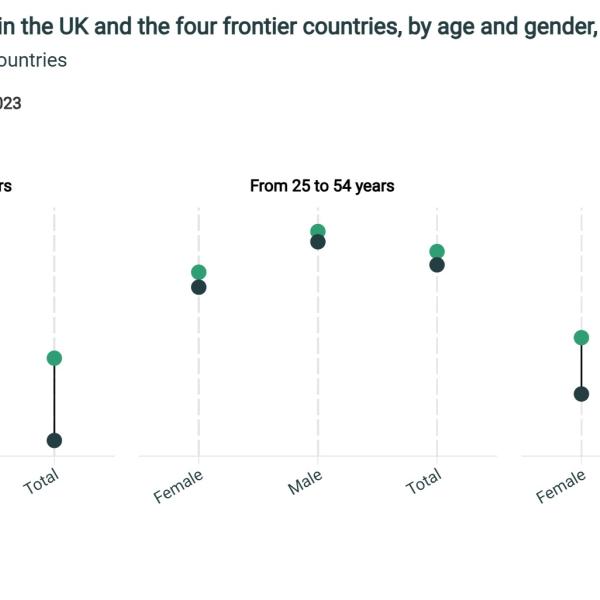In recent years, some of the most talked-about trends in the UK labour market have concerned the growth of ‘non-standard’ or ‘alternative’ forms of work. These have been central to concerns over inequalities stemming from the world of work – either because they are seen as symptoms of a situation in which good opportunities in traditional employment are no longer available for all, or because the newer forms of employment are themselves seen as helping to drive new inequalities by undermining workers’ protections or conditions.
In this briefing note, we focus on a relatively easily quantifiable form of ‘alternative’ working arrangement: namely, ‘solo self-employment’ – sole traders or company owner-managers without employees. In recent years, this category accounts for a very large amount of the growth in non-traditional employment forms, and indeed a large amount of the growth in overall employment. It encompasses a variety of non-standard arrangements, such as independent contractors and ‘gig-economy’ workers. Growing concerns about the employment conditions, job security and career prospects of the solo self-employed have made this group highly salient in the policy debate. The self-employed have also been particularly hard hit by the current COVID-19 crisis.
We uncover a number of facts that help us understand the relationship between solo self employment and inequalities. There is great diversity within the group of solo self-employed, and the occupations in which solo self-employment has been increasing include professional jobs as well as those typically found towards the bottom end of the pay scale. But overall this growing group are much more likely to have low earnings than employees. Crucially, there are several pieces of evidence that some of the group are solo self-employed because they cannot find suitable opportunities in traditional employment. They are more likely than employees to want to work more hours than they currently are working, and to have recently been unemployed or inactive – a gap that has opened up only since the turn of the century. And areas with more growth in solo self-employment tend to see less growth in employee wages. To some extent, then, it seems that solo self-employment – and the weaker employment protections that typically exist within it – is something that people have found themselves having to settle for in the absence of better alternatives.
Key findings
1. ‘Solo’ self-employment (that is, sole traders or company owner-managers with no employees) has risen dramatically in the UK since the 1970s. In 1975, 8% of workers were self-employed; by 2019, this had increased to more than 14%. This rise has been entirely driven by ‘solo self-employment’, i.e. own-account workers without employees. Solo self-employment accounts for over a third of all employment growth since the onset of the financial crisis. The level and growth of solo self-employment in the UK are among the highest in OECD countries.
2. The solo self-employed earn less than employees on average and the gap has widened over time. Median pre-tax earnings among the solo self-employed in 2018–19 were 30% lower than those among employees. Over half of the solo self-employed earned less than £300 a week, compared with just a third of employees, though the shares with very high earnings are similar, owing to more polarised earnings among the self-employed. Their median real earnings have dropped significantly since the onset of the financial crisis, and in 2018–19 were still 13% below their pre-crisis level. By comparison, employee earnings had recovered their pre- financial-crisis level by 2016–17.
3. The recent rise in solo self-employment has taken place across the wage distribution. The increase in solo self-employment has not been confined to low-paid jobs. Its prevalence increased among high-paid occupations such as managers and IT professionals as well as among hairdressers, cleaners and drivers, reflecting a shift in the contractual nature of work across a wide range of occupations. The share of workers who are solo self-employed has increased relatively evenly across the wage distribution.
4. Many enter solo self-employment from unemployment or inactivity. Nearly a quarter (23%) of new solo self-employed workers were unemployed in the previous quarter, and a further 31% were inactive. The recent rise in solo self-employment has not been driven by flows from unemployment – not surprising given that, until COVID-19, unemployment had been at historical lows. But relative to employees, the solo self-employed do appear to be an increasingly marginalised group: they were no more likely to have been recently unemployed or inactive than employees in 2000, but by 2019 they were 45% more likely to have been. Moreover, consistent with solo self-employment being a fall-back option, the share of solo self-employed workers who were recently out of work increased sharply around the Great Recession.
5. Many solo self-employed workers are underemployed. The solo self-employed work fewer hours than employees and the self-employed with employees. They have had the highest level of underemployment throughout the past 20 years, with more than 15% wanting to work longer hours at the peak of the recession and close to 12% in 2019. Again, the gap between the solo self-employed and employees has widened over time. Whilst rates of underemployment were roughly the same across employees and the solo self-employed in 2000, by 2019 the solo self-employed were 28% more likely to want longer hours. This suggests that the solo self-employed are increasingly those with poor alternative options.
6. A higher prevalence of solo self-employment is associated with downward pressure on employee wages – further evidence that it is, in part, a symptom of a lack of opportunity in the traditional employee–employer labour market. When looking both across countries and across parts of the UK, areas that experience increases in solo self-employment tend to also experience slower growth in employee wages. This suggests that some of the solo self-employed play a similar role to the unemployed, in providing a ‘reserve army’ of potential employees which reduces the bargaining power of existing employees, and hence restrains wage growth. This in turn suggests that some of the solo self-employed would opt for traditional employment if they could secure the opportunity: for them, self-employment is a fall-back option rather than a preference. Notably, this seems to be true for some professionals as well as those in lower-paid occupations.
6. However, well-being is higher among the solo self-employed. Prior to the pandemic, the solo self-employed had higher levels of job satisfaction, were more likely to report being happy and to consider their lives worthwhile, and reported lower levels of anxiety than employees. There may be non-pecuniary benefits that compensate for lower earnings, even for those who only became self-employed as a result of poor labour market opportunities. That said, the well-being of the self-employed as measured in relatively stable economic times may not fully account for the additional risks and insecurities that some of them face, which can come home to roost during more turbulent times such as the current crisis.











